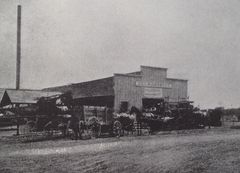George N. Herbert Packing Company
| Business |
Dried Fruit Packer,Cannery |
|---|---|
| Main Location |
San Jose |
| Active |
1890's-1920's |
| Brands |
Herbert's Extra, Buymore |
See Also: "Edith Daley visits George Herbert Packing Company":http://vasonabranch.blogspot.com/2012/11/edith-daley-visits-herbert-packing.html
Locations
| Location | Years | Address | Details |
|---|---|---|---|
| Coyote | 1916 |
George N. Herbert bought parts of Thomas Fisher estate. | |
| Reedley | 1919 |
cannery for apricots, cling, and freestone peaches. | |
| Reedley | 1922 | ||
| San Jose | 1896 | Lincoln Avenue corner of Moorpark |
Drier |
| San Jose | 1900 |
San Francisco Call 1900 list of dropoff locations for California Cured Fruit Association. | |
| San Jose | 1901, 1902, 1904, 1906, 1917, 1918 | Lincoln Avenue near Sansevain | |
| San Jose | 1919 | Third and Keyes (1919) |
Still exists? |
| San Jose | 1919 | Monterey Highway |
Dried fruit plant. |
Details
Interior photo from 1890's packing house in Sunsweet Story, p. 23.
"George N. Herbert plan on Lincoln Avenue burned on June 30, 1901 - 450 tons of prunes, and buildings covering an acre burned. Narrow gauge tracks on fire. 250 tons were owned by the California Cured Fruit Association, rest belonged to Herbert except for 20 tons owned by Seglemen Brothers of New York, awaiting shipping instructions." Rebuilt in 40 days according to
History of Coast Counties Report on fire in July 1, 1901 San Jose Evening News - "piles of prunes glowing like volcanoes".
Became associated with California Prune and Apricot Growers in 1917, packer for 1917 season.
Sold packing house to California Prune and Apricot Growers in 1918.
Expected to can 130,000 cases of fruit in 1919 at Third and Keyes, mostly apricot, peaches, pears, cherries acc to Western Canner and Packer (800 tons apricots, 8000 tons tomatoes, 2000 tons peaches, 750 tons pears, 250 tons cherries). 500 women and girls to be employed.
Herbert will be canning 10,000 tons of peaches for the California Canning Peach Growers association, 160-200 tons per day in San Jose, 5-10 carloads of fruit rolling in a day. California Packing Corporation was supposed to get the business, but they couldn't agree on prices.
July 21, 1923 San Jose Evening News Became Sunsweet. plant #6.
Pacific Rural Press, October 7, 1916: "George N. Herbert has purchased 110 acres of the Thomas Fisher estate, a short distance south of Coyote, for between $70,000 and $75,000. Mr. Herbert stated that he purchased the property owing to the great richness of the soil, which he considers the best prune land in the valley. His 25 years' experience in the packing business has taught him that the largest and highest quality prunes are raised in the territory running from Edenvale to several miles south of Coyote. He stated also that the biggest production of prunes comes from this section."
Herbert bought the George Frank Fruit Company cannery in April 1919 according to
California Fruit News, April 26, 1919 New property included land, planning on new buildings, cured fruit packing plant, warehouse. Expecting to buy 200-300 acre of orchard land. Directors of new company are George N. Herbert, S. G. Tompkins, J. Q. Patton, B. H. Barthold of San Francisco, D. W. Johnson of San Francisco.
In July 21, 1917 San Jose Evening News list of Sunsweet collection stations.
Description of cannery in
San Jose Evening News, July 19, 1919 Cannery planned for Fourth and Keyes, San Jose (1919)
Advertised as "Herbert Packing Company, successors to George N. Herbert"
California Fruit News, July 31 1920 Canned under "Buymore" brand.
1922 California Fruit News announces Van Camp isn't planning on moving to California, Herbert Packing will stay independent. The dried fruit is already exported, but this year's canned fruit production will also start going into export. The list of officers names the export manager. (
California Fruit News, April 1 1922 Also mentions new Reedley plant pairing up with "San Jose plants".
1925 "Herbert's Extra bartlett pears" fruit label shows plants in Reedley and San Jose. (
Label Sold Encina orchard at Coyote to Douglas Sim for $150,000. 100 acres of prunes, 10 of apricots. (
San Jose Evening News, April 22, 1920 Headline showed it as largest sale of the year.
Bought Reedley Cannery from Anderson Bangrover, which picked it up as part of a bankruptcy. Had been Reedley Canning Company (
California Fruit News, March 18, 1922 (According to Marthas Gardens plan, building is on southeast corner of Third and Keyes, and still exists.) ( "Martha Gardens memorandum to San Jose city planning commission":http://www3.sanjoseca.gov/clerk/agenda/12_16_03docs/12_16_03_12.5(a).attA.htm
Bought parts of Thomas Fisher estate Also Encina orchard. (-1920)
Herbert contracted to can for the California Canning Peach Growers' Association in 1923; his canneries would handle the association's 10,000 tons of fruit at the San Jose and Reedly canneries. Each cannery was expected to process 160 to 200 tons of peaches a day; the value of the contract was expected to be $1,000,000. Herbert would advance the canning cost and handle selling. The growers had previously used the California Packing Corporation, but switched to Herbert and two smaller canners after a dispute over prices[1].
References
- ↑ Geo. Herbert Signs Contract for Peach Crop: San Jose Evening News, July 21, 1923
